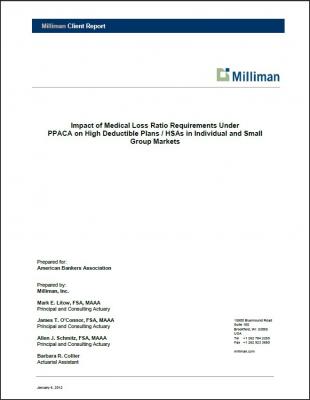Affordable Care Act makes high deductible, low cost health plans, LESS affordable

A new study, released February 13, 2012, confirms what we’ve known for a while, the Affordable Care Act’s Medical Loss Ratio (MLR) rule instead of making plans more affordable will make affordable plans more difficult to find.
Yesterday, a study conducted by Milliman, Inc, found that the MLR calculation is biased against high deductible plans (HDPs) such as those that offer Health Savings Accounts (HSAs). This bias will create disincentives for insurance companies to offer these low premium plans, and thus will reduce their availability to consumers.
The MLR simply determines what percentage of every insurance premium dollar is spent on health benefits. Under the regulation health insurers must spend no less than 80% to 85% of every premium dollar on “health improvement activities.”
But the MLR calculation is biased against HDPs because it does not take into account health claims paid by individuals and employers.
Recent articles have claimed that the Medical Loss Ratio rule would make it difficult1 or impossible2 for HDPs to operate in Obamacare’s Health Insurance Exchanges.
While the Milliman study does not paint the picture quite that bleak,3 it does make several observations about the negative impact of the MLR on HDPs. Here’s our summary of three of the reports major points:
1. The MLR makes it harder for HDPs to compete against higher-cost low-deductible plans. The MLR does not consider funds from a HSA as health improvement activities. This makes it harder for HDPs to meet the required minimum 80%-85% ratio compared to low-deductible plans. According to Milliman,
For high-deductible and HSA plans to be viable, both from a consumer and carrier perspective under the PPACA, an adjustment to the MLR formula for the impact of HSAs may be necessary.4
2. The MLR makes it difficult for HDPs to build reserves in low-claim years to balance out unexpected high-claim years. Because HDPs have high deductibles they may pay fewer claims, but when they do pay claims, they are higher-than-average in cost. The net effect is that HDP plans are more volatile than low deductible plans. Before the MLR, the “fat,” lower-than-average health claim years under HDP plans would make up for the “lean,” higher-than-average health claim years. Now, the MLR will make it more difficult for HDPs to prepare for the “lean” years because it will have to issue rebates in the “fat” years.5 The report states,
This is of particular concern for the year 2011 MLR rebate determination because the calculation includes only one year of experience. This is also true in 2012 for larger plans. In year 2013, three-year averaging takes place, which will help reduce, but not eliminate, this fluctuation rebate risk for high-deductible plans.6
3. The MLR creates disincentives for insurance companies to continue offering low cost HDPs. For the simple reason that HDP premiums are lower, HDP plans take in fewer dollars. This also means fewer dollars for administrative costs. The Milliman study demonstrates that the higher the deductible the more difficult it is for HDPs to maintain the mandated 80%-85% MLR standard. According to the report,
Under normal market conditions . . . total dollars of expenses are already lower for [high deductible] plans than for more expensive (i.e., higher-premium) plans. The MLR requirement results in the need to cut these expenses even more, which may create disincentives to offer such lower-cost plans, particularly if the insurer cannot generate reasonable risk margins.7
Interestingly enough Milliman also says that because deductibles are not indexed to medical inflation, HDP premiums will rise faster than those of low deductible plans. It argues that prior to the MLR, insurance companies had a mechanism to stabilize their loss ratio. But Obamacare’s “unreasonable” rate increase provisions and “the MLR one-sided rebate formula” make it more difficult for HDPs to maintain MLR stability than for low-deductible plans.
What all of this means for consumers is that, ironically, while the “Affordable Care Act” was sold to the public on the premise that it would lower the price consumers pay for insurance, it instead appears that it will make it difficult for affordable HDPs and HSAs to compete with higher-premium plans.
1 David Hogberg, “Obamacare Rule May Bar HSAs, Low-Cost Health Plans,” Investor’s Business Daily, (Dec. 7, 2011) available at http://news.investors.com/Article/594079/201112071853/obamacare-rule-hits-hsa-high-deductible-plans.htm.
2 See Dan Perrin, “The New Medical Los Ratio Rule means No Bronze Plans, and No HSAs in ObamaCare Exchanges,” REDSTATE, (Dec. 5, 2012) available at http://www.redstate.com/dan_perrin/2011/12/05/the-new-medical-loss-ratio-rule-means-no-bronze-plans-and-no-hsas-in-obamacare-exchanges/. This article seems to indicate that it will be impossible for HSA plans to meet the MLR standards. We are not yet convinced that this is the case. And it remains to be seen whether HSA plans will be able to exist in the Health Insurance Exchanges. Much depends on how employee and employer contributions are treated in calculating the “actuarial value” of the plans. (The actuarial value of a plan tells us the percentage of healthcare costs paid for by the health plan).
3 Perhaps, this is because Milliman does not examine the effect on HDPs that “actuarial value” minimums will have as mandated by the Health Insurance Exchanges.
4 Mark E. Llitow, et al., "Impact of Medical Loss Ratio Requirements Under PPACA on High Deductible Plans / HSAs in Individual and Small Group Markets," (Jan. 6, 2012) 3, available at http://www.hsacoalition.org/wp-content/uploads/2012/02/Report-ABAImpactofMedicalLossRatioRequirements.pdf, 8.
5 Milliman makes it clear that the MLR makes an adjustment for small, but not large, HDPs.
6 Supra note 4 at 3.
7 Id. at 6 (emphasis added).